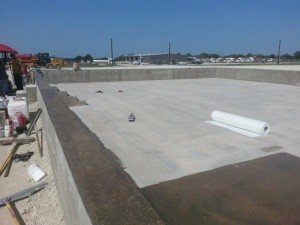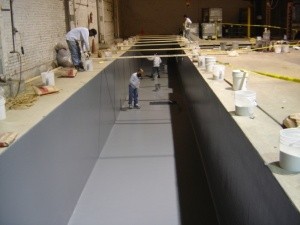 Secondary containment is defined as a means of surrounding one or more primary storage containers to collect any material spills in the event of container failure. It is surprising that some liquids you can drink could cost you thousands of dollars if your tank leaked into surrounding rivers, lakes and ground water. A few years ago, a beverage company had a major spill of a drinkable product and the Environmental Protection Agency (EPA) fined them thousands of dollars. This is because aquatic life in a river will not survive on “soda pop”, a popular drink that contains a mild acidic acid. This is safe for human consumption, but not so much for the fish. This is why it is important for your facility to consider secondary containment and flooring solutions.
Secondary containment is defined as a means of surrounding one or more primary storage containers to collect any material spills in the event of container failure. It is surprising that some liquids you can drink could cost you thousands of dollars if your tank leaked into surrounding rivers, lakes and ground water. A few years ago, a beverage company had a major spill of a drinkable product and the Environmental Protection Agency (EPA) fined them thousands of dollars. This is because aquatic life in a river will not survive on “soda pop”, a popular drink that contains a mild acidic acid. This is safe for human consumption, but not so much for the fish. This is why it is important for your facility to consider secondary containment and flooring solutions.
Regulations on secondary containment for hazardous materials consist of 5 main considerations:
- The containment area must be resistant to spills and free of cracks and open areas.
- The containment area should be sloped or designed to quickly and easily remove spilled liquid.
- It must have sufficient capacity to contain at least 10% of total volume of the primary containers or 100% of the largest container.
- Rain must be prevented from entering the containment area unless the containment area has sufficient capacity to hold additional volume plus the requirements.
- Material that has spilled or leaked into the secondary containment area must be removed as soon as possible to prevent overflow.
 State and local codes for secondary containment are different for different areas of the United States. It is always advised to check your local EPA offices for local secondary containment codes as these codes are frequently revised.
State and local codes for secondary containment are different for different areas of the United States. It is always advised to check your local EPA offices for local secondary containment codes as these codes are frequently revised.
Materials used for containment areas
Concrete is the more common material used in construction of containment areas. Since concrete is a porous material that allows liquids to pass through, these concrete containment barriers must be coated to ensure spill containment by using secondary containment and flooring solutions to prevent concrete contamination. Fiber glass reinforced polymers are usually applied to concrete secondary containment structures used for protection of chemical spills. They must have protective linings or coatings to prevent spills from attacking the porous concrete and/or penetrating existing cracks and control joints. These polymer resin systems are fluid applied coatings or linings and are installed on site.
Epoxy vinyl ester resins provide the best overall resistance to a wide range of acids, alkalis, bleaches and solvents for use in many chemical processing applications. They offer excellent toughness and provide exceptional thermal resistance properties. The secondary containment and flooring solutions are designed to be applied as a coating, seeded floor or fiberglass reinforced system, providing impact and crack bridging characteristics.
Ultimately, secondary containment is an essential environmental protection measure, even for substances that may seem harmless. A spill of any liquid, regardless of toxicity, can disrupt local ecosystems and wildlife if released unchecked into soil or waterways. Though meeting containment regulations requires precise in facility design and maintenance, doing so prevents far more costly remediation down the line. And because codes vary based on jurisdiction and are frequently updated, managers must research the specific standards for their site.
With the right containment materials and capacity, facilities can help ensure their operations avoid preventable environmental incidents and maintain compliance. Partnering with experienced vendors for containment solutions tailored to their needs is the smartest way for businesses to accomplish their goals.
Is chemical containment a concern in your business processes? Protective Industrial Polymers offers a complete line of vinyl ester coating and containment systems. Click the following link to learn more about InhibiChem Vinyl Ester Systems.
- Are Vinyl Ester Coatings and Linings Really Necessary? - November 3, 2016
- Does Your Process Require Secondary Containment….Even If Your Spills Are Drinkable? - September 19, 2016

